
Like other beaches in Binh Thuan, Co Thach beach attracts tourists with colorful rocks. the rocks are pushed from the bottom of the sea and rise to the water surface. The rocks have many shapes and sizes.
The rocks were formed hundreds years ago. It is 0.9 kilometers in length and 200-300 meters in width with the reserves of 243,900 cubic meters. Tourists are impressive with different colours of the rocks: brown, yellow, violet, green, white, etc. Under the sun, the rocks become more twinkling and stunning. Co Thach beach does not only have colourful rocks but also big stones and interesting legends. Some stones are similar to elephants, some are similar to ostrichs, others are like holding hands. Surrounding the beach, there is a pristine sand called Bai Tien. According to the legend, there were a lot of fairies dancing and singing here. In addition, there is a cave that is ingrained into the mountain and leads to the back of Lau Trong of Hang pagoda. Visting Co Thach, tourists can hire a tent and set camping fire with only 50,000 VND a time in order to contemplate the moon and enjoy squid – the specialty of this land.     |
Friday, May 31, 2013
SEVEN-COLOUR ROCKS IN CO THACH BEACH
Coming to Binh Thuan, you should visit Co Thach tourist area which is very famous for Hang pagoda, and stunning seven-colour rocks.
Wednesday, May 29, 2013
Bach Ma - Centre of flora Diversity
Situated in central Vietnam, in Thua Thien Hue province, around 700 km south of the country's capital Hanoi and 1,000 km north of Ho Chi Minh City. The park surrounds an area of about 22,000 ha in the districts of Phu Loc and Nam Dong. Bach Ma mountain peak is the highest point in the park, with 1450-m altitude and only away 18 km from the coast.

Bach Ma National Park has a tropical climate with 2 distinct seasons, dry season and rainy season. Therefore, Vietnam guider introduces tourists that they might be surprised at the changeable weather, which goes from sunshine to darkness, and clouds to rains. Mainly from September to December, it receives at about 8,000-mm rainfall every year. You are able to encounter hot and dry winds from May to August and even typhoon from June to November.
Does the name Bach Ma ("white horse") arouse in your mind any association? In Vietnamese tradition, it refers to the white cloud which continually caps its peak. On approaching the park, you will see the evidence of Vietnam War remains in the form of some hills that still have not been fully recovered from the spraying of defoliants.
Nature’s gift
Bach ma's position, at the sharing border with Northern and Southern Vietnam, is combined with a variety of habitats, ranging from the coast to high mountains. The flora of Bach Ma contains 2,147 species which represents around one-fifth of the entire flora of Vietnam. Among these, 86 species are listed as endangered species in the Red book of Vietnam. The main vegetation types comprise moisture green forest, montane forest, and scrubby-grass covering area much occupied by the locals
Fauna
Bach Ma National Park takes pride in its endemic and rare species. Up to now, 1,493 species including 132 species of mammals (half of which are well known in Vietnam), 358 bird species, 31 reptile species, 21 frog species, 57 fish species and 894 insect species are identified. The elusive Sao la (Pseudoryx nghetinhensis) was only discovered in Vietnam in 1992. Do not be surprised if you see a pheasant!, this species used to be common in forests at the mountain foot, yet was already considered to be extinct by the 1940s. More than 50 years later, it was rediscovered in the park and has become the symbol of Bach Ma National Park.
Activities in buffer zone
This huge biodiversity has created the amazing paradise on the ground for nature-lovers! There is a range of activities carried out with the collaboration of local people in the villages of the national park's buffer zone. One of them is the establishment of medicinal plant gardens in Khe Su village, located about 2 km far from the park entrance. The village encourages tourists who travel to Vietnam to devote some 40,000 VND (more than USD2) for its development fund.
If you are eager for bird-watching, you are in the right place! More than one-third of the bird species of Vietnam are found in here! You can see a number of pigeons, bulbuls, malkohas, crow pheasant, herons and egrets but sights of parakeets, kingfishers or jungle fowl!
Incredible! How can I get there?
Bach Ma National Park is relatively easily accessible from Hue (40 km), Da Nang (65 km) and Hoi An (90 km). The park headquarters and entrance are about 3km from the tiny town of Cau Hai, where the park road meets National Route No1. Bus is the ideal means of transport if you would like to contemplate the landscape along the road. There’s a railway station in Cau Hai, and frequent buses from Hue and Da Nang.
Monday, May 27, 2013
Cat Co Beach-Ideal destination for the weekend
There are hundreds of large and small beaches in Cat Ba but Cat Co beach including Cat Co 1,2,3, is the tourist attraction with romantic and poetic landscapes.
Visiting the large beach of Cat Co, visitors will have the chance to enjoy the fresh air of sea and swim in the blue and warm water, so clear that you can see the golden sand bneath.
The white-sand Cat Co beach make a great place to lounge around for the day. They are about 1 km southeast from Cat Ba town over a steep headland; and can be reached on foot or by motorbike. Cat Ba is the biggest island (100 sq. km) out of the 366 islands on the Lan Ha Bay. It is a tourist spot, attractive for its natural beauty and wonders endowed by nature. Right from the moment you set foot on Cat Ba gangway, looking afar to contemplate the enchanting scenery of immense sky and magnificent mountains and breathing the fresh air from the sea, you will feel comfortable and your tiredness after a long trip will disappear. Surely, you want to go on with your journey at once.
Cat Co Beach is separated by a small hillock that can be climbed over in about 20 minutes. However, you can take the easier route along a new wooden seaside walkway around the mountain. The beach offers simple accommodation and camping. The mountain adjacent to Cat Co Beach has a tunnel and fascinating caves and grottoes, such as Hang Luon, Khe Sau, Trung Trang, Gia Luan and Kim Cuong.
The white-sand Cat Co beach make a great place to lounge around for the day. They are about 1 km southeast from Cat Ba town over a steep headland; and can be reached on foot or by motorbike. Cat Ba is the biggest island (100 sq. km) out of the 366 islands on the Lan Ha Bay. It is a tourist spot, attractive for its natural beauty and wonders endowed by nature. Right from the moment you set foot on Cat Ba gangway, looking afar to contemplate the enchanting scenery of immense sky and magnificent mountains and breathing the fresh air from the sea, you will feel comfortable and your tiredness after a long trip will disappear. Surely, you want to go on with your journey at once.
Cat Co Beach is separated by a small hillock that can be climbed over in about 20 minutes. However, you can take the easier route along a new wooden seaside walkway around the mountain. The beach offers simple accommodation and camping. The mountain adjacent to Cat Co Beach has a tunnel and fascinating caves and grottoes, such as Hang Luon, Khe Sau, Trung Trang, Gia Luan and Kim Cuong.

Visiting these caves and grottoes you will get the feeling of the explorers, discovering the wonders and mysteries endowed by nature. The fauna living on the Cat Ba National Park is diverse: 20 kinds of animals, 69 kinds of birds, 20 kinds of reptiles, rare wild white - headed langurs. Coming out of the caves and grottoes you should spend a little time to contemplate the sunset over Lan Ha Bay. on the golden background of the horizon and the dark blue of the sea, the heaving islets become multiform, the white sea-gulls hover and sea-eagles make circles in the sky, all beautifying the immense and fascinating space, and enchanting the visitors. Cat Co Beach is a tourist spot, attractive for its natural beauty and wonders endowed by nature.
Friday, May 24, 2013
Co Loa - Special national relic
The Co Loa archeological, architectural and historical relic site got a certificate recognising it as a special national relic on February 14
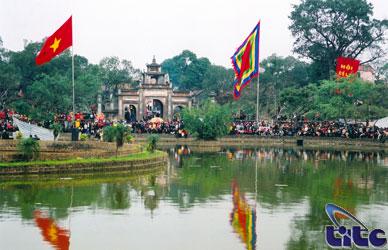
The Hanoi authorities have been paying great attention to conserving and restoring its cultural vestiges, including Co Loa, in coordination with developing tourism, which promotes Vietnam’s traditional cultural identity, added Nhan for Vietnam travel guide.
For her part, Deputy Chairwoman of the Hanoi municipal People’s Committee Nguyen Thi Bich Ngoc requested the city’s departments, industries and authorities to continue preserving and restoring the relic.
Co Loa is a relic complex of unique architectural and archeological value. The focal point of the complex is a three-round spiral citadel with 16km in length, an outstanding example of Vietnamese and Southeast Asian architecture.
Co Loa was the ancient capital of the Vietnamese state of Au Lac during the reign of King An Duong Vuong 2,300 years ago.
The Co Loa archeological, architectural and historical relic site got a certificate recognising it as a special national relic on February 14
The ceremony was jointly held by the Hanoi municipal and Dong Anh district People’s Committees and Thang Long Hanoi Heritage Conservation Centre. Deputy Prime Minister Nguyen Thien Nhan, central and municipal officials, overseas visitors and locals attended the event.
The ceremony was jointly held by the Hanoi municipal and Dong Anh district People’s Committees and Thang Long Hanoi Heritage Conservation Centre. Deputy Prime Minister Nguyen Thien Nhan, central and municipal officials, overseas visitors and locals attended the event.
Addressing the ceremony, Nhan affirmed that Co Loa’s new status was to add historical and cultural value to the relic.

The Hanoi authorities have been paying great attention to conserving and restoring its cultural vestiges, including Co Loa, in coordination with developing tourism, which promotes Vietnam’s traditional cultural identity, added Nhan for Vietnam travel guide.
For her part, Deputy Chairwoman of the Hanoi municipal People’s Committee Nguyen Thi Bich Ngoc requested the city’s departments, industries and authorities to continue preserving and restoring the relic.
Co Loa is a relic complex of unique architectural and archeological value. The focal point of the complex is a three-round spiral citadel with 16km in length, an outstanding example of Vietnamese and Southeast Asian architecture.
Co Loa was the ancient capital of the Vietnamese state of Au Lac during the reign of King An Duong Vuong 2,300 years ago.
Hanoi expects to welcome 15.5 mln tourists in 2013
Hanoi expects to serve 15.5 million tourists, including 2.25 million foreigners, in 2013, Deputy Director of the municipal Department of Culture, Sports and Tourism Mai Tien Dung said on February 26.
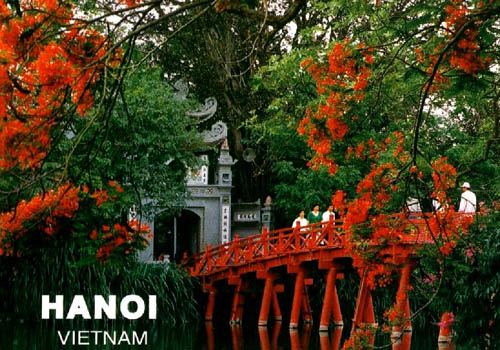
The city also attracted 12.3 million domestic tourists.
Also in 2012, Hanoi was rated the best destination in Vietnam for city life by Lonely Planet Traveller, the world’s leading tourist magazine.
Hanoi, together with Hoi An, made the 2012 top 10 attractive destinations in Asia, as chosen by Smart Travel Asia, a Hong Kong online tourist magazine.
The capital city of Vietnam came second in a list of 100 international cities with good hotel services, which was compiled by the well-known tourism website Trivago.
During the traditional Lunar New Year (Tet) festival from February 9-18, the capital city received 2.08 million tourists, including 60,000 foreigners, representing a year-on-year increase of 11 percent.
Despite the global economic recession last year, Hanoi welcomed 2.1 million foreign visitors, an increase of 11.3 percent from 2011, and one-third of all foreign visitors to Vietnam – a new record for the city.
Despite the global economic recession last year, Hanoi welcomed 2.1 million foreign visitors, an increase of 11.3 percent from 2011, and one-third of all foreign visitors to Vietnam – a new record for the city.

The city also attracted 12.3 million domestic tourists.
Also in 2012, Hanoi was rated the best destination in Vietnam for city life by Lonely Planet Traveller, the world’s leading tourist magazine.
Hanoi, together with Hoi An, made the 2012 top 10 attractive destinations in Asia, as chosen by Smart Travel Asia, a Hong Kong online tourist magazine.
The capital city of Vietnam came second in a list of 100 international cities with good hotel services, which was compiled by the well-known tourism website Trivago.
Tuesday, May 21, 2013
Tan Chau Silk Making Village
Tan Chau silk has its fame because of the softness, toughness, long-wearing and high absorbability of natural silk material. All clothes made from Tan Chau silk bring to people comfort, coolness in summer, warmness in winter. Tan Chau silk is deserved to be called “Queen” of silk.
Not only for legends and remains, Tan Chau silk village in An Giang is also famous for the brilliant past of a special craft village.
Tan Chau silk has its fame because of the softness, toughness, long-wearing and high absorbability of natural silk material. All clothes made from Tan Chau silk bring to people comfort, coolness in summer, warmness in winter. Tan Chau silk is deserved to be called “Queen” of silk.

Tan Chau silk is deserved to be called “Queen” of silk.
Actually, materials for making Tan Chau silk are all produced by local people themselves. They grow shrubbery feeding silkworm to generate silk, plant mac nua (D. mollis) tree to take its fruit making dye. To make a unit of Tan Chau silk, the makers must spend many time and labor in many different parts of process. Firstly in silk choosing part, the maker must select the good type of silk to squeeze, seize on the loom then put on the weaving pattern. After finishing weaving, weaver starts the part of making dye. The big and young mac nua fruits are selected (the ripe ones are not suitable because of not having resin), kneaded well in mortar or in crushing machine and then dissolved in water, creating a nice yellow liquid which will turn into black when meeting the air and temperature. This liquid is filtered to leave the residue and used for dying.

Mac nua (D. mollis) fruit to make the dye
The part of dying silk is considered the most important and most elaborate one in the whole process which includes a hundred times of soaking silk in dye to ensure that each silk thread absorbs equally After each soaking time, people have to use their hands carefully squeezing silk then hang it out. When drying, they must choose the suitable sunny days in order to dry silk 4 units of sunlight per day. If being hang out in rain or light sunshine, the quality of silk will decrease. After about 40-45 days of dying and drying, the product is taken in new process becoming beautiful clothes which make people to contemplate and to praise because of their brilliant beauty.
Because of the long time and much labor for making Tan Chau silk, its price is very high. In about 60s -70s of 20th century, this kind of product was not suitable for daily needs of people then slowly came to disappearance. The internal market refused it due to its expensiveness while color was the reason for the refusal of external market.

Makers have found other dying technique to generate different colors
However, for recent years, due to the common direction of development and fashion trend leading to high quality products which express cultural features, the brand of Tan Chau silk begins to be restored and returned into deserved position. Besides the traditional black color of natural dye from mac nua fruit, Tan Chau silk makers have found other dying technique to generate different colors, meeting the customer’s requirements which are more various day by day. This is a valuable chance for a famous craft village, which has been down for a long time, to restore its thriving past.
Thursday, May 16, 2013
MYSTERIOUS MO SO CAVES
Mo So is a limestone mountain range in Kien Giang Province’s Kien Giang Town which is famous for Hang Pagoda, Phu Tu Islet, Thach Cave and Da Dung Islet.
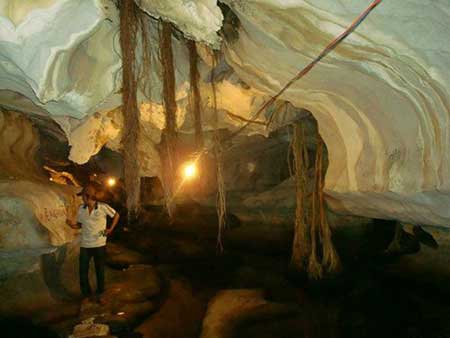 A view of Mo So Cave.
However, one often overlooked spot is Mo So, which is recommended as an attraction for travelers who are brave enough to journey into its mysterious caves.
The road to Mo So from Kien Giang Town entertains visitors with its shining golden rice fields and windy limestone mountains. Like other mountains, Mo So is endowed with many caves which used to be military bases in wartime. The first stop is Quan Y (army medical corps) Cave which is 300 meters long. The cave lures tourists by small wooden bridges, soil bags functioning as paths for travelers to step on, tiny gloomy lakes as well as its many bats. Colorful lights beaming on rock walls arouse imagination for visitors. You can see a dolphin leaning its mouth to the cave’s heart, a white dragon soaring on the clouds or a Buddhist hand. Knocking on that hand, visitors will be startled by rock melodies echoing on the mountain walls. After some distance the cave comes to light by glistening sun rays over wild flowers and green moss hanging on the wall and on stalactites. Water drops from the gate fulfill the gorgeous setting. Moving from Quan Y to Voi Rong Cave, you will see nature in its glory. Touring to Mo So, tourists should not forget to admire a valley which is about 700 square meters and about 20 meters above sea level. Standing amidst the valley, tourists will be amazed by the clouds around, the whistle of winds and blue streams through rocks. In the rainy season, tourists can take a boat cruise around the attraction to get lost in one of the riddles of nature. |
Tuesday, May 14, 2013
On the Rocky Plateau
Dong Van plateau is known as one of the 77 geological parks in the world and the second in Southeast Asia after the Langkawi Geological Park in Malaysia. With an immense area of limestone mountains and deserts of rugged rocks, the plateau is also called the land of rocks. Yet, the locals have, for thousands of years, attached their whole lives to their native land and earn their living on small pieces of land on the rocky mountains.
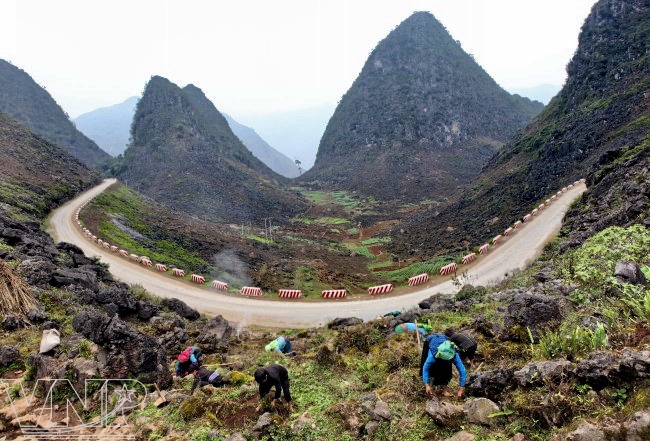
Every year in March, when it is still cool the Mong people go to the field to prepare
for a new crop.
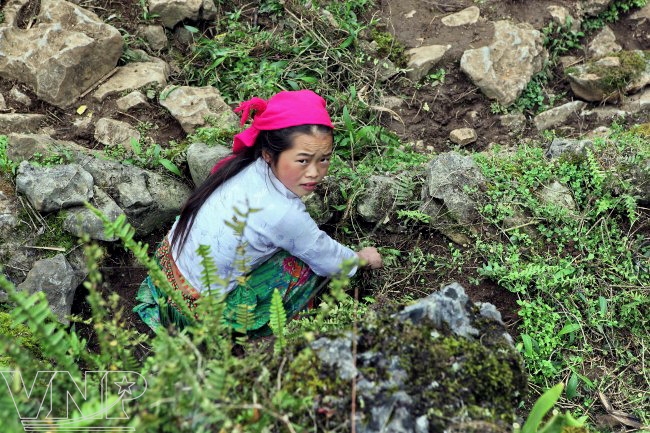
A little of soil in pot-holes is used to grow plants.
Farming on the rocky ground.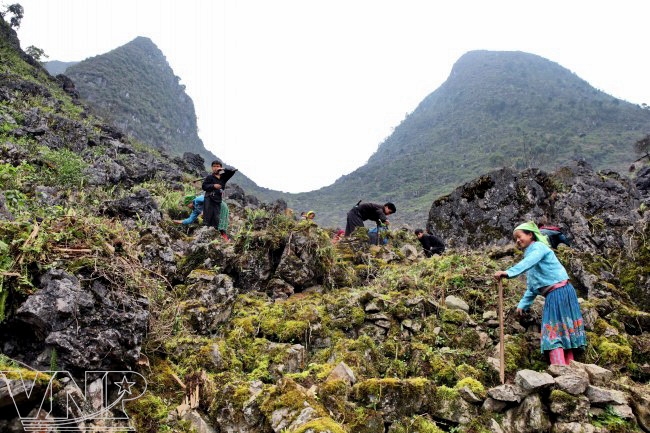
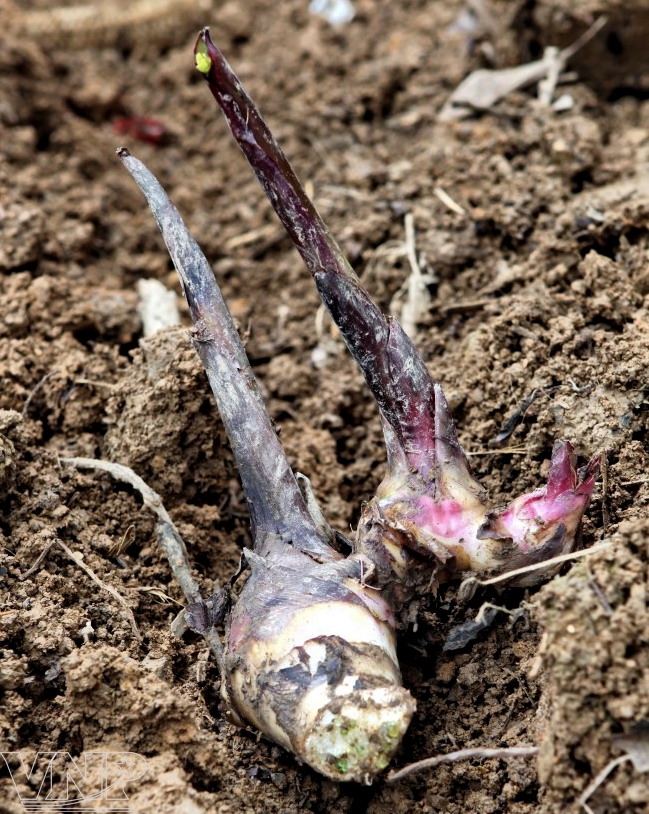
Edible canna is one of the major plants in the area. area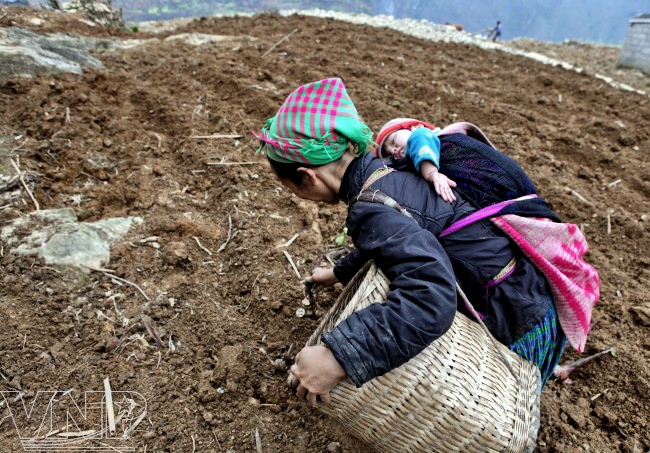
Sleeping on her mother's back.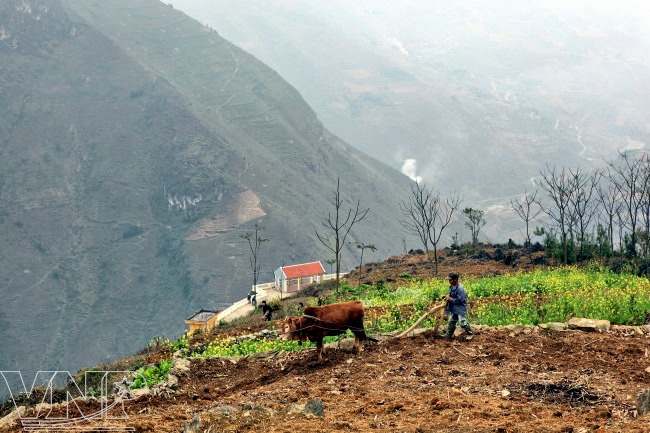
Fields on the mountain side.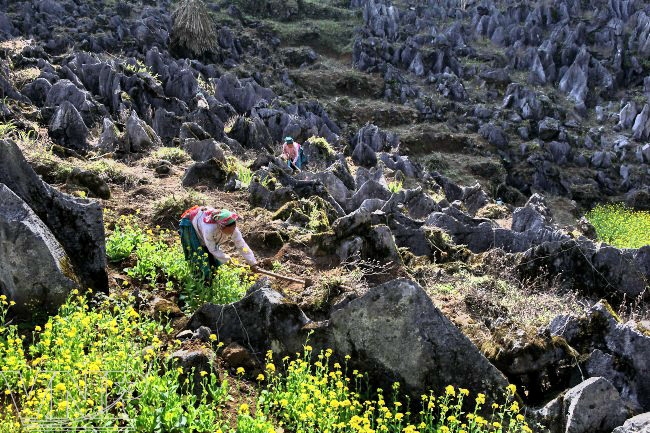
The yellow of colza flowers is seen on the rocky mountains.
Going to the northern mountain provinces, tourists may see rocks on both sides of the road. In the background of the grey colour of rocks is the green of crops on small plots scattered on the rocky ground. The plants seem to absorb all nutriments from the thin layer of land on pot-holes to bud and turn into verdant carpets, covering the rocky area
Every year in March when it is still cool, ethnic groups, mainly the Mong people prepare for a new crop. To make the seeds sprout and grow well, they must toil in the fields for several days. They use a special farming tool to dig deep in pot-holes on the mountain, then carry the soil from the foot of the mountain and put them in every pot-hole before sowing seeds.
Every year in March when it is still cool, ethnic groups, mainly the Mong people prepare for a new crop. To make the seeds sprout and grow well, they must toil in the fields for several days. They use a special farming tool to dig deep in pot-holes on the mountain, then carry the soil from the foot of the mountain and put them in every pot-hole before sowing seeds.

Every year in March, when it is still cool the Mong people go to the field to prepare
for a new crop.

A little of soil in pot-holes is used to grow plants.

Farming on the rocky ground.


Edible canna is one of the major plants in the area. area

Sleeping on her mother's back.

Fields on the mountain side.

The yellow of colza flowers is seen on the rocky mountains.
http://www.vietnamtourism.org.vn/vietnam-in-photos/nature-adventure/on-the-rocky-plateau.html
Friday, May 10, 2013
A JOURNEY TO DISCOVER CHAU DOC
Chau Doc is located on the charming confluence, meeting Con Tien and Chau Giang. Coming here, you can discover cuisine and many tourist attractions with pleasure.
Tourist attractions
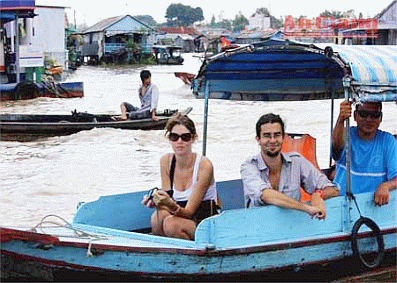
Chau Doc town has many historical, cultural relics and unique landscapes. The monuments is ranked by Ministry of Culture consits of Tay An pagoda, Thoai Ngoc Hau Tomb, Ba Chua Xu temple, Hang pagoda, Chau Phu. Besides, there are some other destinations also attracting a lot of tourists such as: the village of Cham people in Chau Giang, Vinh Te canal, fishing village, Tao Ngo garden, fort on Sam mountain.
Leaving Chau Phu, tourists will come to the most unique destination in Chau Doc - the floating fishing village. Each raft here is designed as an apartment. Rafts stretch along both banks of the river.
Especially, recently, some local people have tended to settle in raft being only 4 meters in width and 7-8 meters in length. Jolly-boats, and boats are local people’s major transports in the floating village.
The next destination is Ba Chua Xu shrine. Her statue is a work of art made of stone. Her posture is deliberate like a god statue in India, Laos and Cambodia. Annually, the shrine attracts millions of visitors.
Leaving the shrine, travellers come to Hang pagoda (alternative name is Phuoc Dien Tu) located severally in the west of Sam mountain slope. It attracts travellers with legend of sprite and poltergeist.
Discovering cuisine Chau Doc has many famous specialities. One of them is fish sauce. "Mắm thái"
Especially, “Mắm thái” rolled in girdle cake comes with herbs and white rice vermicelli. Besides, there are many dishes cooked with fish sauce: pork cooked with fish sauce for a long time, fish sauce hot pot – the speciality of Chau Doc people.
In addition, white rice vermicelli with fish is sold a lot in the town. Cooks process the broth for rice vermicelli from snake-head marinated with citronella, saffron. Rice vermicelli will come with bean sprouts, water spinach, sliced banana flower.
Another specialities are Tra fish, and basa fish. The fish is dried and its stomach is processed for special appetizer – the deep-fried basa fish’s stomach.
Besides, that the urban space is large and airy is a strength supporting for the development of evening cuisine area in Chau Doc. The cuisine area is around the square of Chau Phu A ward, two parks A and B and is along Le Loi street in Chau Phu B ward.
|
Tuesday, May 7, 2013
MU CANG CHAI – THE HOME OF GOLDEN TERRACED RICE FIELDS IN VIETNAM
Mu Cang Chai is a western district of the Yen Bai province in Northern Vietnam. Mu Cang Chai is famous for its terraced fields. The terraced fields here are mostly located in three towns: La Pan Tan, Che Cu Nha and Ze Xu Phinh. These three towns were ranked as National Famous Landscapes. Due to that, from September to October, the fanciful scenery of terraced fields during the harvest season attracts many photographers to this area.

The mountain pass, Khau Pha, with a 30km-long, and high slope, make the Northwest area full of obstacles and difficult to access, but deep in mystery. After overcoming the mountain pass, visitors will be satisfied with the view of the terraced fields in the dusky mist and pure white clouds. The terraced fields, as hundreds of different soft ridges, make up the framework of this land with an altitude over 1000m, which captivates hearts.
The all-yellow hillsides of ripe rice seedlings, circling around the terraces – all of these things make up a dreamy beauty; enchanting, romantic and serene. This is a very distinguishing beauty; generous for all visitors, but only during the special Mu Cang Chai harvest season. There are also round roads – no matter how many times visitors turn around, they will be surprised by Mu Cang Chai’s amazing beauty in each turn. Terraced fields and ripe rice seedlings are mixed under the hands of nature, creating an endless sea of yellow. These appear and disappear alternately with the small houses of the ethnic people, which stretches to the top of mountain. 
Mu Cang Chai’s beauty is not only shown by the miraculous scenery, but also the human presence here. The vision of the ethnic people harvesting the ripe, full-yellow rice seedling is like a mixture of colors, brightening up the corner of the Northwest sky. The pattern on the colorful costumes of the ethnic people here is drawn by beeswax mixed with color.
Therefore, the costumes of the ethnic people in Mu Cang Chai always have special colors that no other dyes can create. Normally, people here harvest in the afternoon, since it’s the time when the sunshine is most bright. People are hurrying for the harvest season, otherwise all of the ripe seedling rice will fall down and there will be no more sunshine to dry it up. There are families with relatives of all generations to help with harvesting. Families take turns harvesting from one family to the next until it’s all harvested. Even the Red Dao ethnic minority woman brings her newborn baby with her while in the fields to harvest. 
After one enjoyable day, you can stay in Mu Cang Chai one night in an ethnic minority house or hotel. You will be surprised by what Mother Nature has given this place the following morning. In the early morning, the sky is brightened up with a perfect combination of light blue and golden yellow, as well as a trove of clouds as fluffy waves. Besides that, there are some pathways along the bottom of the mountain; meandering, curving, to meet the sky at the horizon, creating a true sense of beauty.
Mu Cang Chai, with its own distinguishing beauty and a mysterious attraction, keeps tourists coming back to this place again and again, not only because of the natural scenery, but also because of the friendly, warm and open people here.  |
Friday, May 3, 2013
Discovering Doi Cave in Dong Nai
The distinction was given to a cave in Tan Phu District after scientists from the Vietnam Institute of Tropical Biology and the Berlin Caving Club spent two months surveying 11 lava caves in the province.


One of the entrances to Doi Cave in Dong Nai Province – Photo: Doan Xa
The arc-shaped cave, named Doi (Bat) by locals, is 534 meters long including a damaged segment, while its intact portion is 426 meters long, beating Indonesia’s Gua Lawah Cave, which is 400 meters long.
Doi Cave is four meters high and 10 meters wide at the largest part, with some parts the height of an average person.
Scientists also found copious amounts of mud on the floor of the rocky cave, and determined it had arrived there via floods during rainy seasons. Bats, snakes, centipedes, scorpions, and amphibians were also found inhabiting the cave. Therefore, local authorities have set up signboards banning people from catching bats in the cave to protect its biodiversity.
After finding this information, we made a journey to the edge of Cat Tien National Park to try and see the new cave despite the intense heat.
Doi Cave is four meters high and 10 meters wide at the largest part, with some parts the height of an average person.
Scientists also found copious amounts of mud on the floor of the rocky cave, and determined it had arrived there via floods during rainy seasons. Bats, snakes, centipedes, scorpions, and amphibians were also found inhabiting the cave. Therefore, local authorities have set up signboards banning people from catching bats in the cave to protect its biodiversity.
After finding this information, we made a journey to the edge of Cat Tien National Park to try and see the new cave despite the intense heat.
We were lucky to have Nguyen Van Lam, a 60-year-old local as our guide to the cave lurking in the dense forest. The first entrance to the cave Lam took us to was pretty narrow and to enter we needed some equipment such as an oxygen cylinder, mask, flashlight and rope as it was very dark, slippery, narrow and foul-smelling due to bat droppings.
Lam said there were four other cave entrances behind that one and all of them are home to thousands of bats. However, locals do not dare to enter the cave as the entrances are small and filled with rocks and soil. Lam said if someone wants to come into the cave this way would require a lot of hard work.
During our cave-exploration, Lam took us to seven cave entrances, of which some are located right on the pepper and banana farms of locals.
There was only one entrance which had easy access but because it is very deep in the mountain we could only spend a short time there as it was too dangerous.
For the first time, we had a chance to admire giant lave works formed from volcanoes and we thought they would be a great attraction for tourists later. We also found out that bats just live in caves formed by lava and stay away from caves formed from white and grey rocks.
Lam said there were four other cave entrances behind that one and all of them are home to thousands of bats. However, locals do not dare to enter the cave as the entrances are small and filled with rocks and soil. Lam said if someone wants to come into the cave this way would require a lot of hard work.
During our cave-exploration, Lam took us to seven cave entrances, of which some are located right on the pepper and banana farms of locals.
There was only one entrance which had easy access but because it is very deep in the mountain we could only spend a short time there as it was too dangerous.
For the first time, we had a chance to admire giant lave works formed from volcanoes and we thought they would be a great attraction for tourists later. We also found out that bats just live in caves formed by lava and stay away from caves formed from white and grey rocks.
Subscribe to:
Comments (Atom)